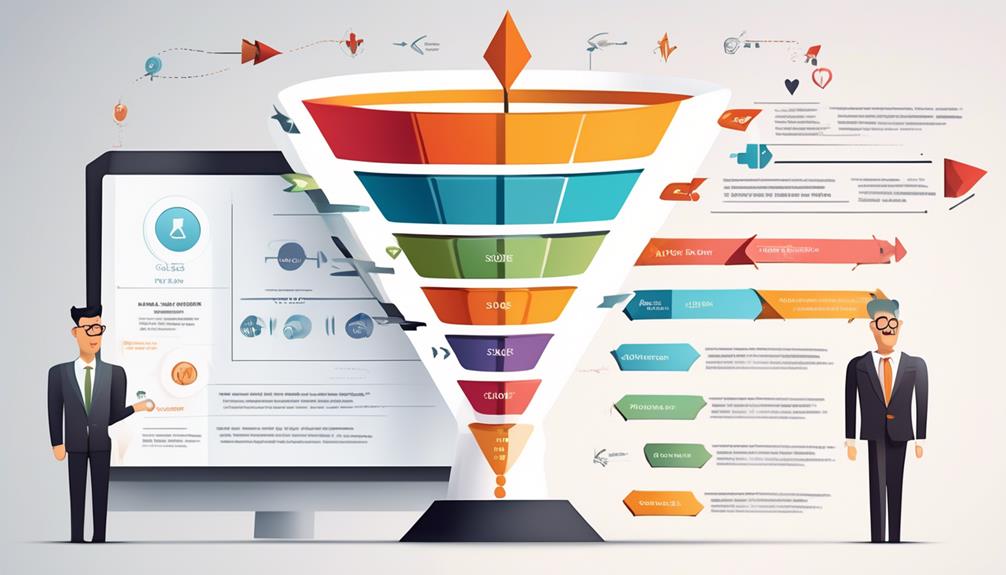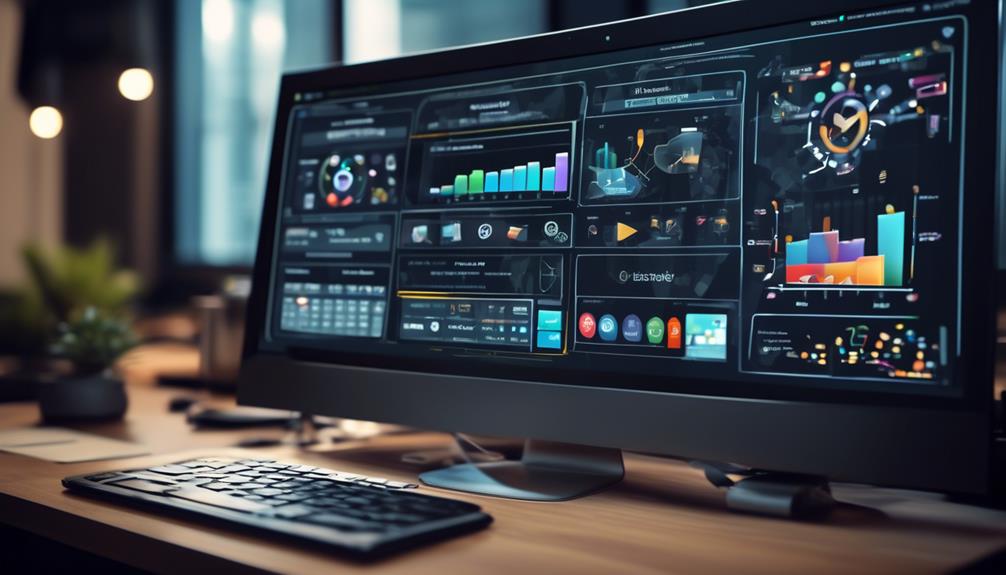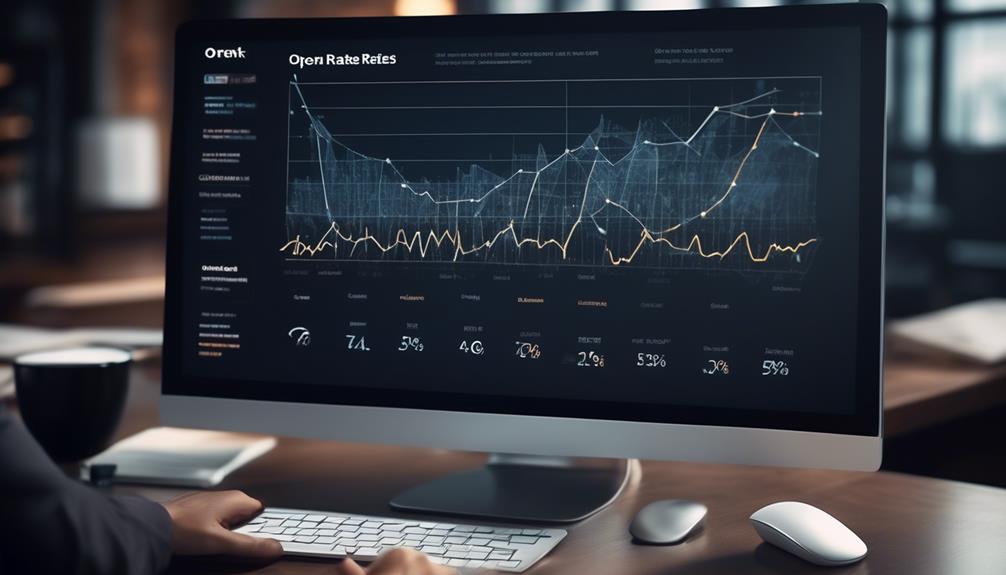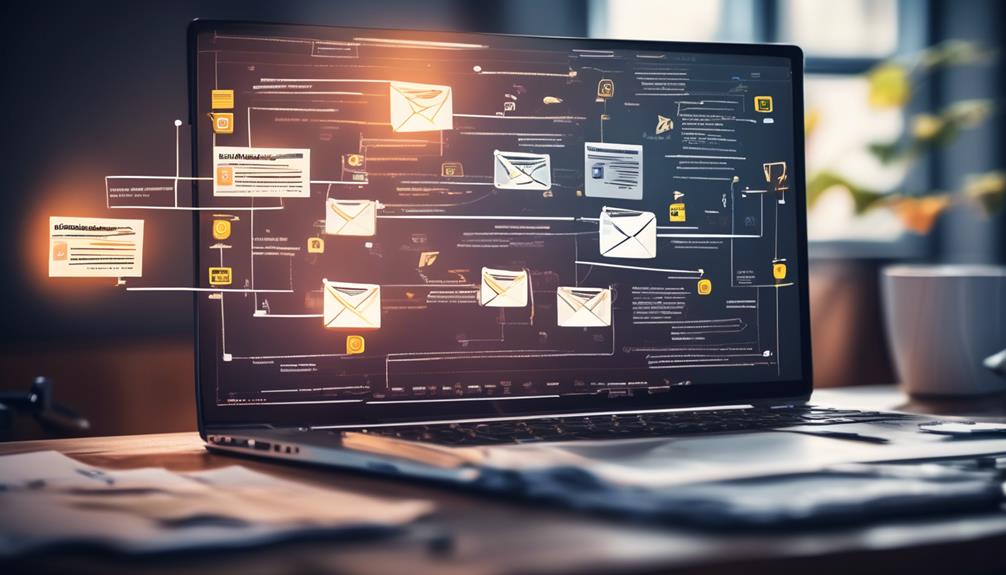Have you ever felt swamped by the labor-intensive process of individually sending sales emails to potential customers?
Well, there's a more efficient way to manage your sales process. By automating your sales email sequences, you can streamline your workflow and focus on building meaningful connections with your leads.
But how exactly can you achieve this? Let's explore the 6 essential steps to automate your sales email sequences and revolutionize your approach to prospect engagement.
Key Takeaways
- Email sequences are a powerful tool for nurturing leads and guiding them through the sales funnel.
- Audience segmentation and buyer persona development are essential for creating personalized and targeted email content.
- Crafting compelling email content requires understanding the demographics, behavior, and pain points of your ideal customers.
- Implementing automation tools and analyzing performance metrics are crucial for optimizing and improving email sequences.
Understanding Email Sequences
Understanding email sequences plays a crucial role in automating sales processes and effectively engaging leads and prospects. Automated email sequences are a powerful tool in the sales and marketing arsenal. These sequences are carefully crafted to nurture leads through various stages of the sales funnel.
Lead nurturing is essential for guiding potential customers towards conversion, and email sequences are instrumental in this process. By delivering targeted content at the right time, you can increase the likelihood of converting leads into customers.
One type of email sequence, known as onboarding email, is designed to familiarize new customers with your product or service, setting the stage for a successful customer journey. Additionally, conversion emails are strategically crafted to encourage leads to take action, such as making a purchase or signing up for a demo. These sequences aren't only time-based but can also be personalized based on the recipient's behavior, ensuring that the content remains relevant and engaging.
Understanding the intricacies of email sequences is essential for creating effective and impactful communication that drives results in sales and marketing efforts.
Identifying Target Audience

You need to start by researching and gathering data to understand your ideal customer's demographics and behavior.
Using customer personas will help you segment your audience and tailor your email sequences accordingly.
Analyzing past interactions and sales data will allow you to identify patterns and preferences of your target audience.
Audience Segmentation
To improve the effectiveness of your sales email sequences, it's essential to identify specific characteristics or behaviors that define your target audience. Use data and analytics to segment your audience into distinct groups, allowing you to tailor your email content and messaging to resonate with each segment's unique needs and preferences.
Implement personalized and relevant communication to increase engagement and conversion rates. By continuously analyzing and refining your audience segmentation strategy based on performance metrics and feedback, you can ensure that your automated emails are effectively reaching and influencing your audience.
This targeted approach not only enhances the impact of your email marketing campaigns but also strengthens your sales outreach to existing customers. Utilize email marketing software and platforms to create a conversion sequence that aligns with each segmented group's interests and behaviors.
Buyer Persona Development
How can you effectively identify the specific characteristics and attributes of your ideal target audience for buyer persona development? To ensure the success of your automated email sequences, it's crucial to understand your customers' demographics, behaviors, and preferences. Here's how to do it:
- Conduct surveys, interviews, and market research to gain valuable insights into your target audience's needs and motivations.
- This data will help you tailor your email series to resonate with your ideal customers.
Creating detailed buyer personas will enable you to set up automated email sequences that are personalized and targeted, ultimately leading to higher engagement and conversions. Remember, buyer persona development is an ongoing process, requiring continuous analysis and adaptation to keep your sequences relevant and effective for your existing customers.
Ideal Customer Profile
Understanding the specific characteristics and attributes of your ideal target audience through buyer persona development is a crucial step in identifying your ideal customer profile for effective automated email sequences.
By determining the demographics, behavior, and pain points of your target audience, such as industry, job title, company size, and challenges they face, you can create detailed buyer personas to represent your ideal customers.
Use data analysis to identify common traits of your most valuable customers and prospects, allowing you to continuously refine and update your ideal customer profile based on customer feedback, market trends, and performance data.
This detailed understanding of your ideal customer profile will enable you to tailor your sales outreach, cold emails, and call to action within your marketing automation to convert leads and acquire new customers more effectively during the sales cycle with quality content.
Crafting Compelling Email Content

Crafting compelling email content requires understanding your audience's needs and preferences in order to deliver personalized and engaging messages. When crafting your sales outreach, consider the following to ensure your email series resonates with your audience:
- Personalization: Tailor your email content to address the specific pain points and interests of your recipients. Use their names and personalize the content based on their previous interactions with your brand.
- Segmentation: Divide your audience into smaller segments based on their behavior, preferences, or demographics. This allows you to send more targeted and relevant emails, increasing open rates and click-through rates.
Crafting compelling email content is crucial for nurturing email leads and converting them into customers. Your emails should provide helpful information, address common challenges, and offer solutions.
Additionally, incorporating a follow-up email strategy can significantly improve engagement and conversions. By crafting compelling email content that resonates with your audience, you can effectively drive results and maximize the impact of your automation sequences.
Implementing Automation Tools

To implement automation tools effectively, select a reliable software that allows for trigger-based email sequence automation. When choosing an automation tool for your sales email sequences, it's essential to ensure that it supports trigger-based automation, enabling you to set predefined criteria and triggers for initiating email sequences automatically. This functionality empowers you to personalize email sequences based on user behavior or time-based preferences and schedule emails at specific intervals or times, optimizing the effectiveness of your sales funnel. Here's a comparison table to help you understand the different types of email sequences and the triggers used to send them:
| Type of Email Sequence | Trigger to Send |
|---|---|
| Welcome Email Sequence | User subscribes or signs up |
| Re-engagement Email | User shows inactivity |
| SEO Content Email | New SEO content published |
| Sales Funnel Email | User progresses in the funnel |
Analyzing Performance Metrics

Now let's talk about analyzing performance metrics to improve your email sequences.
Tracking open rates, click-through rates, and conversion rates gives you valuable insights into the effectiveness of your emails.
Metrics Analysis
Evaluating performance metrics such as open rates, click-through rates, and conversion rates is crucial for gauging the effectiveness of your email sequences. When it comes to metrics analysis for your automated email sequences, consider the following:
- Understanding Engagement: Analyzing metrics helps you understand how recipients engage with the series of emails, allowing you to tailor future sequences for better results.
- Optimization Opportunities: By tracking metrics, you can identify areas for improvement and optimize your free email sequence to build trust and resonate with your audience effectively.
Analyzing performance metrics is essential for your sales outreach. It empowers your sales team to make data-driven decisions, refine email sequences, and maximize the impact of your email campaigns.
Improving Email Performance
Understanding how recipients engage with your email sequences is crucial for improving email performance and analyzing performance metrics. By tracking open rates, click-through rates, and conversion rates, you can measure the effectiveness of your automated email sequences. Additionally, utilizing A/B testing allows you to compare different subject lines, content, and sending times to optimize performance. Analyzing engagement metrics provides valuable insights into subscriber behavior and preferences, while monitoring unsubscribe rates and spam complaints helps gauge the effectiveness of your emails. To continuously improve your email performance, use the data collected to make informed decisions and refine your email sequences. The table below summarizes the key metrics to track for email performance analysis.
| Metric | Description | Importance |
|---|---|---|
| Open Rate | Percentage of recipients who open the email | Indicates email subject line and sender effectiveness |
| Click-Through Rate | Percentage of recipients who click on links | Reflects email content and call-to-action performance |
| Conversion Rate | Percentage of recipients who take the desired action | Measures email effectiveness in driving the desired outcome |
What are the Benefits of Automating Sales Email Sequences?
Automated email sales sequences offer numerous benefits for businesses. They ensure timely and consistent communication with leads and customers, saving time and effort while increasing engagement and conversions. With personalized content and targeted messaging, automating sales email sequences can effectively nurture leads and drive sales.
Iterating and Optimizing Sequences

To enhance the effectiveness of your sales email sequences, regularly review and analyze performance metrics to identify areas for improvement. This continuous optimization process ensures that your automated email sequence is a series of emails automatically sent at the right time and resonates with your audience.
To achieve this, consider the following strategies:
- Test different subject lines, email copy variations, and send times to optimize open and click-through rates.
- Utilize A/B testing to compare the effectiveness of different elements and iterate based on results.
- Leverage customer feedback and data to continually refine and enhance the email sequence content and structure.
Staying updated with industry best practices for sales outreach and incorporating innovative strategies allows you to build email sequences that resonate on a personal level. By iterating and optimizing sequences, you can ensure that each email is a trigger to send the right message at the right time, ultimately driving better engagement and conversions.
Frequently Asked Questions
How Do I Create an Automated Email Sequence?
To create an automated email sequence, start by defining your goals and mapping out the specific actions or triggers that will initiate the sequence.
Utilize behavior-based segmentation to personalize content and improve engagement.
Choose a modern email marketing platform like Active Campaign, Drip, or MailChimp, which offer user-friendly interfaces for building automation sequences.
Craft compelling, targeted content that aligns with your audience's preferences and behaviors to maximize effectiveness.
How Do You Automate Sales Emails?
Struggling to automate sales emails?
Start by defining your target audience and their needs.
Use automation software to trigger emails based on specific actions or time delays.
Craft compelling content and include strong calls-to-action.
Monitor performance and continuously optimize your sequences for better results.
Remember, personalization and relevance are key to engaging leads and driving conversions.
Mastering this process will elevate your sales email game and boost your business growth.
How Do You Create a Sales Email Sequence?
To create a killer sales email sequence, there are several key steps to follow:
- Craft compelling subject lines and engaging content. The subject line is the first thing that your prospects will see, so make sure it grabs their attention and entices them to open the email. Once they open it, the content should be interesting and valuable, providing them with useful information or insights.
- Tailor each email to your prospect's journey. Understand where your prospects are in the buying process and create emails that address their specific needs or pain points. This will help to establish a connection and build trust with your prospects.
- Include a clear call-to-action. Every email in your sequence should have a clear next step for your prospects to take. Whether it's scheduling a demo, requesting more information, or making a purchase, make sure it's easy for them to understand what you want them to do.
- Plan a sequence that spans a few weeks. Instead of sending one-off emails, create a series of emails that are sent out over a period of time. This allows you to gradually build rapport and trust with your prospects, increasing the likelihood of a sale.
- Personalize your emails based on prospect behavior or time triggers. Use automation tools to track your prospects' behavior and send them personalized emails based on their actions. For example, if they visited your pricing page, you can send them an email with more information about your pricing plans.
- Always track and analyze the performance of your sequences. Use analytics tools to measure the open rates, click-through rates, and conversion rates of your emails. This data will help you identify what is working and what needs to be improved, allowing you to fine-tune and optimize your sequences for better results.
What Are the Steps in Email Automation?
To automate your emails, begin with a clear goal and map out the number and duration of emails based on your objective.
Create a framework of key points to cover and draw inspiration from sales scripts.
Experiment with subject lines and visuals to gather valuable data.
Gradually tweak and refine each aspect to optimize your email sequence and drive successful automation.
Conclusion
Now that you've automated your sales email sequences, are you ready to see your sales soar?
With the right tools and strategies in place, you can save time, nurture leads, and increase your revenue.
So, what're you waiting for?
It's time to take your sales process to the next level and watch your business grow!










